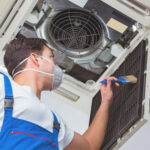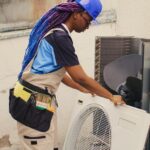
Improving Indoor Air Quality with Proper Ventilation
Improving Indoor Air Quality with Proper Ventilation
Proper ventilation is more than just a matter of comfort—it’s essential for maintaining healthy indoor air quality. From homes to offices, ensuring adequate airflow can significantly impact our well-being. In this blog, we delve into the crucial role of ventilation in improving indoor air quality. We’ll explore why it matters, how it affects our health, and most importantly, practical tips for optimizing ventilation systems to breathe easier and live healthier. Let’s embark on a journey to understand the power of proper ventilation in creating safer, more comfortable indoor environments.
The Vital Role of Proper Ventilation
Proper ventilation is the cornerstone of a healthy indoor environment. It regulates temperature, removes pollutants, and replenishes oxygen levels, ensuring occupants breathe clean, fresh air. Effective ventilation prevents the buildup of harmful gasses, volatile organic compounds (VOCs), and allergens, reducing the risk of respiratory issues and other health problems.
Additionally, it helps control humidity levels, preventing mold and mildew growth. Whether in residential or commercial settings, prioritizing proper ventilation is crucial for promoting well-being and comfort.
Understanding Indoor Air Quality
Indoor air quality (IAQ) refers to the cleanliness and purity of the air within buildings and structures. It encompasses various factors, including pollutant levels, humidity, temperature, and airflow. Poor IAQ can result from a combination of factors such as inadequate ventilation, indoor pollution sources, and insufficient maintenance of HVAC systems.
Common indoor pollutants include dust, pollen, mold spores, pet dander, tobacco smoke, and chemicals emitted from household products. Understanding IAQ is essential for recognizing potential health risks and implementing measures to improve air quality, ultimately creating healthier and more comfortable indoor environments.
Impact of Ventilation on Health
The quality of ventilation directly affects human health in numerous ways. Proper ventilation reduces the concentration of indoor pollutants, preventing respiratory issues, allergies, and other health problems. Inadequate ventilation can lead to the accumulation of harmful gasses, such as carbon dioxide, volatile organic compounds (VOCs), and airborne pathogens, exacerbating asthma, allergies, and respiratory infections.
Moreover, poor ventilation contributes to indoor humidity levels, creating an ideal environment for mold growth, which can trigger allergies and respiratory issues. Prioritizing effective ventilation systems is crucial for safeguarding the health and well-being of building occupants.
Signs of Poor Ventilation
Identifying signs of poor ventilation is crucial for enhancing indoor air quality, preventing pollutants, discomfort, and health issues, allowing owners and occupants to take proactive measures. Here are some common signs of poor ventilation:
- Lingering Odors: Poor ventilation can cause persistent odors in indoor spaces due to accumulation of pollutants like cooking fumes, tobacco smoke, pet dander, and mold, indicating inadequate air exchange and circulation.
- Stuffy or Stale Air: Poorly ventilated spaces can cause discomfort, breathing difficulties, and a general sense of unease due to the lack of fresh outdoor air and movement.
- Condensation on Windows: Condensation on windows indicates high indoor humidity and poor ventilation, leading to moisture buildup and mold growth. Unaddressed issues can cause water damage and deterioration of building materials.
- Visible Mold or Mildew Growth: Mold growth on surfaces indicates poor ventilation and high humidity levels, promoting fungal growth in damp, poorly ventilated environments. Addressing ventilation issues and controlling humidity is crucial for a healthy indoor environment.
Importance of Adequate Airflow
Adequate airflow is essential for maintaining optimal indoor air quality and ensuring the comfort and well-being of occupants. Proper airflow facilitates the dilution and removal of indoor pollutants, including dust, allergens, and volatile organic compounds (VOCs), thereby reducing the risk of respiratory issues and allergies.
Moreover, adequate airflow helps regulate temperature and humidity levels, preventing the buildup of moisture and inhibiting mold and mildew growth. By promoting ventilation, adequate airflow also enhances cognitive function, productivity, and overall comfort in residential, commercial, and institutional settings.
Health Risks of Poor Ventilation
Poor ventilation poses significant health risks to occupants by allowing the accumulation of indoor pollutants and compromising air quality. Without sufficient airflow, indoor spaces become stagnant, trapping pollutants such as carbon dioxide, airborne pathogens, and volatile chemicals emitted from building materials and furnishings. Prolonged exposure to these pollutants can lead to a range of health problems, including respiratory infections, asthma exacerbations, allergic reactions, and other respiratory issues.
Additionally, inadequate ventilation contributes to indoor humidity, fostering the growth of mold, which further exacerbates respiratory problems and poses serious health risks, especially to vulnerable individuals such as children and the elderly. Addressing poor ventilation is crucial for mitigating these health risks and promoting a healthier indoor environment.
Benefits of Good Indoor Air Quality
Indoor air quality (IAQ) enhances health, productivity, and comfort, promoting well-being and overall quality of life in buildings by prioritizing its maintenance and improvement. Here are four key benefits of good indoor air quality:
- Healthier Environment: Maintaining good indoor air quality (IAQ) reduces indoor pollutants, reducing respiratory issues, allergies, and other health problems, supporting immune system function, and reducing the risk of respiratory infections.
- Enhanced Cognitive Function: Clean air enhances cognitive function, concentration, and mental clarity, improving decision-making skills, productivity, and overall cognitive performance by reducing indoor pollutants and ensuring adequate ventilation.
- Increased Comfort and Well-being: Good indoor air quality (IAQ) promotes relaxation, satisfaction, and well-being by ensuring fresh, clean air, optimal temperature, and humidity levels.
- Long-term Health Benefits: Investing in good indoor air quality (IAQ) benefits occupants by reducing chronic diseases, improving respiratory health, and reducing cardiovascular disease risk, contributing to sustainable, healthy indoor environments for future generations.
Tips for Optimizing Ventilation Systems
Building owners and occupants can improve indoor air quality and overall well-being by optimizing ventilation systems and implementing effective strategies. Here are four key tips for optimizing ventilation systems:
- Regular Maintenance: Regularly inspect and maintain ventilation equipment, clean filters, and ensure ductwork is free of obstructions and leaks to maintain optimal airflow and quality in the building.
- Balance Airflow: Balancing airflow distribution is crucial for consistent ventilation in buildings, ensuring uniformity and comfort by adjusting vents, dampers, and registers to prevent stagnant air pockets.
- Utilize Energy Recovery Ventilation (ERV) or Heat Recovery Ventilation (HRV): Install energy recovery ventilation (ERV) or heat recovery ventilation (HRV) systems for energy efficiency, fresh air ventilation, consistent indoor temperatures, and reduced energy costs.
- Implement Demand-Controlled Ventilation (DCV): DCV systems utilize sensors and intelligent controls to adjust ventilation rates based on occupancy and indoor pollutant concentrations, enhancing energy efficiency and maintaining indoor air quality.
Choosing the Right Ventilation Methods
Selecting the right ventilation methods is crucial for maintaining indoor air quality and occupant comfort, influenced by factors like building size, occupancy patterns, and local climate. Here are four key ventilation methods to consider:
- Mechanical Ventilation: Mechanical ventilation systems, including exhaust-only, supply-only, and balanced systems, regulate airflow and remove indoor pollutants, utilizing fans and ductwork to effectively control indoor air quality.
- Natural Ventilation: Natural ventilation uses passive airflow through windows, doors, vents, and other openings to circulate fresh air, promoting energy efficiency and reducing reliance on artificial cooling and heating.
- Hybrid Ventilation: Hybrid ventilation is a system that combines mechanical and natural ventilation techniques to enhance indoor air quality, energy efficiency, and performance in various building environments.
- Demand-Controlled Ventilation (DCV): Demand-controlled ventilation systems (DCV) utilize sensors and intelligent controls to adjust airflow rates based on occupancy and indoor pollutant concentrations, enhancing energy efficiency and maintaining indoor air quality.
Ventilation in Homes: Best Practices
Implementing best practices for ventilation in residential settings is essential for creating a healthy and comfortable indoor environment. Start by properly sizing ventilation systems to match the specific needs of the home and its occupants. Install exhaust fans in bathrooms and kitchens to remove moisture, odors, and indoor pollutants effectively.
Consider whole-house ventilation systems, such as HRVs or ERVs, to provide continuous fresh air while recovering energy from outgoing air streams. Regularly maintain ventilation systems by cleaning filters, ducts, and vents to ensure optimal performance and air quality. Lastly, promote natural ventilation by opening windows and doors whenever possible to refresh indoor spaces with outdoor air.
Ventilation in Offices: Creating a Healthy Environment
In office environments, ventilation plays a critical role in creating a healthy and productive workspace for employees. Implementing proper ventilation systems helps mitigate indoor air pollutants, regulate temperature, and maintain optimal humidity levels. Well-ventilated offices promote employee well-being, reduce the spread of airborne illnesses, and enhance cognitive function and productivity.
Strategies such as incorporating natural ventilation, utilizing air purifiers, and optimizing HVAC systems can contribute to creating a healthier office environment where employees can thrive and perform their best.
Innovations in Ventilation Technology
Advancements in ventilation technology continue to revolutionize indoor air quality management, offering innovative solutions for various settings. Smart ventilation systems equipped with sensors and automated controls adjust airflow based on occupancy, indoor air quality, and external conditions, optimizing energy efficiency while ensuring adequate ventilation.
Additionally, developments in filtration technologies, such as high-efficiency particulate air (HEPA) filters and ultraviolet germicidal irradiation (UVGI), enhance air purification and remove airborne pathogens and contaminants. Furthermore, emerging technologies like photocatalytic oxidation (PCO) and ionization systems show promise in deactivating viruses and improving indoor air quality. These innovations herald a new era of healthier, more sustainable indoor environments.
Prioritizing proper ventilation is not just about comfort—it’s about safeguarding the health and well-being of everyone who occupies indoor spaces. By understanding the importance of ventilation and recognizing the signs of poor indoor air quality, we can take proactive steps to create healthier environments for ourselves and future generations.
At Cool Factory, Inc., we’re dedicated to helping you improve indoor air quality with our expert ventilation solutions. For tailored advice and professional assistance in Sterling, VA, contact us at (703) 713-5113. Let’s work together to ensure that every breath you take indoors is clean, fresh, and revitalizing.






